 Remember Capt. Hook and the crocodile? This circuit is almost the same as a flasher, except instead of an LED it uses a speaker. The result is that it pulses the speaker with a very short pulse of current.
Remember Capt. Hook and the crocodile? This circuit is almost the same as a flasher, except instead of an LED it uses a speaker. The result is that it pulses the speaker with a very short pulse of current.
The circuit uses a 9V battery, but today the 9V battery is too expensive, so I would replace the 9V battery with a single AA cell and a Joule thief to boost the voltage up to about 4 to 6 volts.
The circuit could be changed to a flashing Joule Thief so that the transistors that do the flashing also boost the voltage.
Update Jan 5
I built the circuit on a piece of wood with some tiny screws as the solder points. I made a few changes to it as follows. I changed the BC557 PNP to a SS8550 1 amp audio output transistor. I changed the BC547 to a PN2222A. I changed the 2.2 uF electrolytic to two 1 uF monolithic ceramic capacitors in parallel. I changed the 200k pot to a 600k pot. Instead of 9V, I set the power supply at 4.5VDC, which seemed to be loud enough.
I powered it up and found that it did, indeed, tick like a time bomb. I could vary the tick rate from less than 1 per second to a low buzz of maybe ten per second. But the current on the power supply’s meter was too low to read, so I put the DMM in series with the power supply lead. The meter would read zero until a click, then jump up a little bit, but it wasn’t readable.
To get a stable reading, I put a 10 thousand uF capacitor across the time bomb’s supply leads, and a 100 ohm resistor in series with the positive lead. This filtered out the spikiness of the supply current. When I adjusted the click rate for about 2 a second, the current was under 2 milliamps at 4.5V. When I increased the click rate, the current went up to about 5 milliamps.
That current is so low that it would run for a week or more using three AAA cells. It would be really easy to run it using a single AA cell. If I want to keep the circuit as it is, I would have to add a Joule Thief to convert the 1.5V to 4.5V. That’s easy to do, since the average output current would be 5 milliamps or less, so accounting for efficiency, the JT would draw about 30 milliamps at 1.5V from the AA cell. The output of the JT is rectified and filtered, and a 4.7V zener would be used as a shunt regulator. The time bomb would then be connected across the zener.
The only thing that I don’t like about this is that the shunt regulator wastes most of the power. I could redo the JT so that it is shut down when the voltage gets up to 4.5V, so between clicks, it doesn’t waste much power. But this just adds more complexity to the circuit that already is getting complicated. A better way to go would be to make a flashing Joule Thief, but instead of an LED, it drives a speaker. The circuit itself does the conversion along with the
Tick.. Tick.. Tick..
Back to experimenting…